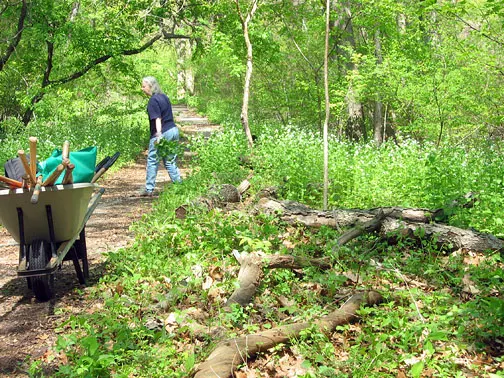On The Work Trail
We went to learn how to move thousand pound quarry stone.
But I am one of those guys, distracted by the greenery all around the trail, who can't put away his camera. Here the garlic mustard, which was profuse and even beautiful at times over that first week of May.
Stone moving a little bit much for this volunteer, she decided to clear the woods of all the garlic mustard.
Poison ivy was everywhere. Its typical red-tinged shiny young leaves in threes.
But then also this specimen, with deeply cut, dull green leaves having confused more than one volunteer.
The trail section as we left it in April.
This in May. The NYNJ Trail Conference trail builders do fine stone work.
There was much new growth near the staircase, including the leafing out of a group of lovely young tulip trees.
And the oaks nearby, likely a red or black oak (pointy leaf serrations).
Celandine -major.
My guess is Rubus phoenicolasius, or Wineberry. I remember these from the Muttontown Preserve. Also growing alongside the embankment staircase. Pretty dull in April, now it's full of interesting plants.

This is another segment of the John Muir Trail. A previously boulder strewn incline, now being improved with quarried steps to minimize mountain biking on the trail (yet probably won't stop it).
The water bar we had practiced moving after it was placed and dug in. Water bars move water off the trail so that fast moving water doesn't erode the trail into a deep gully. And finally...
Part of that day's work was "de-berming" a paved hillside path to allow water to move off the path and into the woods. In the course of this work, volunteers scraped and shoveled many plants out of being. Trail builders do not have the resources to take great care with the trail-side plants while doing renovations. Much like any infrastructure work, the heavy lifting gets done without the light touch of plant protection or relocation. Saving plants is an entirely different frame of mind, and would require the knowledge of which plants are worth saving, how to dig them up, and how to place and care for them until they re-establish. It also requires trail work information before it begins.
I noticed the may apples, a rather obvious species, and decided to spare some. I picked a few out, some missing leaves, and bagged them, poured Poland Spring into the bag, and left them with my things. Of course, it couldn't have been 2 minutes before I was ragged on for stealing park plants by one of the officials. But we're killing them anyway, I argued. The whole affair left us feeling awkward. Of course, we're both right, but...it seems to me that even if I had planted them deeper in the woods, without watering them (who knew if we would get much rain, it being the beginning of a dry week, now we are in a wet one), I suspected they had little chance of surviving. In fact, on our last outing volunteers planted a number of plants in a bad spot (under a maturing pine and in the path of moving quarry stone) and most were dead by the time I returned to the site. Anyhow, I must keep reminding myself not to be a gardener when I am helping with trails.
Many of the may apples were in flower. I transported my three stolen (or saved) may apples to my yard, planting them under the yew tree (my best approximation of woodsy shade) and watered them. Three weeks later I am almost surprised to say that they are still alive. If they like it there, they will spread, and then I will need to share them with Prospect Park. I'll call this take and give.
Remember this tree I posted about two weeks ago? Working on an ID. I still think its a weed tree.
It's now leafing out, much later than many of the other species, like tulip tree and oak, around it. I think I know what it is and I simply have been too busy to dig it out of the books. Update: I think it's a mulberry tree, maybe Morus alba.



















Wow to the stonework.
ReplyDeleteRe: tree Paper mulberry? Like other mulberries, it can have various leaf forms on the same tree, some really intricate.
Nice post.
ReplyDeleteSo...the 2nd three-leaf plant. Is it or isn't it?
PS Do you like donuts, and what kind?
Wha? OH, you mean the poison ivy. Yes, both are poison ivy, very much.
ReplyDeleteDonuts for donuts. Alright, that was silly. Anything without the gooey white stuff. And. You shouldn't, but I'll eat whenever you do.
do you know about this electronic field guide? (if only I had an iPhone.../
ReplyDeletehttp://leafsnap.com
Really? I would never have guessed that second leaf was poison ivy. And yes to mulberry. A weed tree? Perhaps, But tasty berries...
ReplyDelete